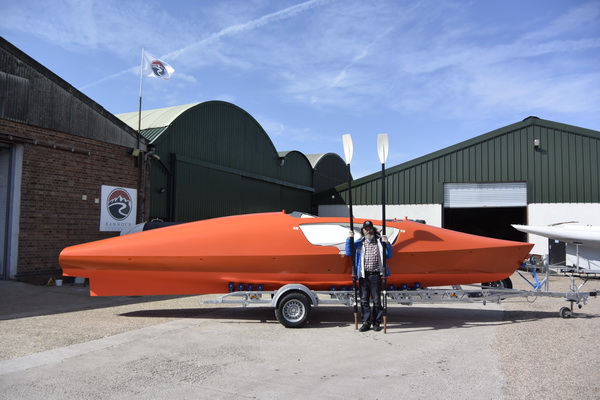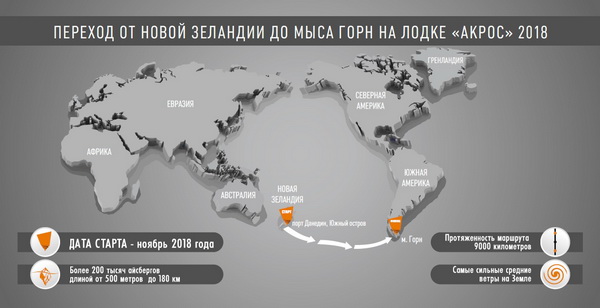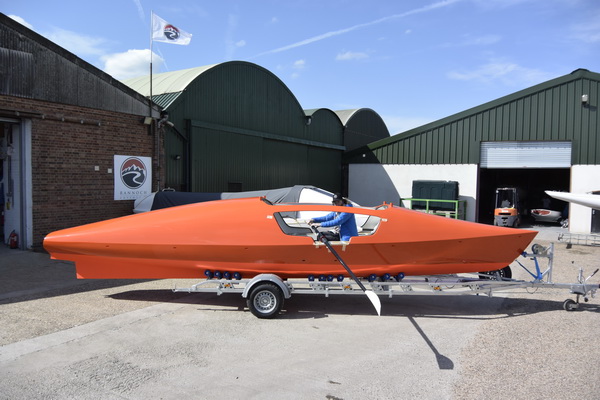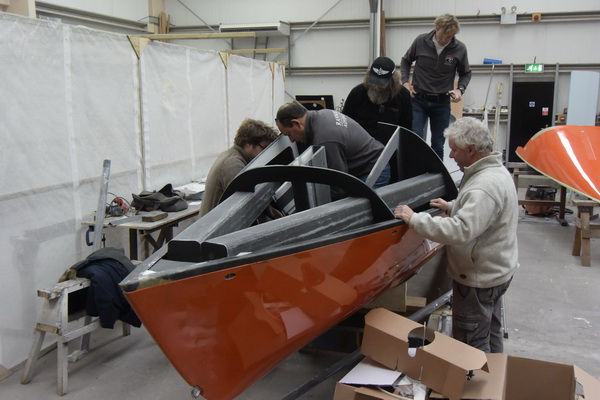Handover of the Rowboat and the Hot-air balloon capsule.
This week was marked by two important events in the project schedule of Fedor Konyukhov’s voyage headquarters.
At the Rannoch Adventure shipyard, the manufacturing of the rowboat “AKROS” hull has been completed. The hull is coloured bright orange. This colour is used for the vessels operating at ‘high’ Arctic and Antarctic latitudes.
In six months’ time, Fedor Konyukhov is planning to start rowing from New Zealand (the port of Dunedin) taking a course to Cape Horn. He set an ambitious and super-complex task: to complete the first round-the-world voyage traversing the Southern Ocean rowing around the three great capes: Cape Horn (South America), cape of Good Hope (Africa) and Cape Leeuwin (Australia). The round-the-world voyage is divided into three phases. The details can be found here.
The rowboat “AKROS” is designed by the British engineer Phillip Morrison. The boat repeats the shape and configuration of its predecessor – the rowboat “Turgoyak/К9”, preserving the same dimensions – 9 meters in length.
The weight of the empty hull is ‒ 400 kg. Additionally, a 100kg of lead had been installed onto the bottom of the hull as an additional ballast required for re-balancing of the boat onto the even keel in the event of the boat’s capsizing in the ocean. Fedor Konyukhov, the project partners, the designer, and the shipyard team all understand that it is impossible to cross the Southern Ocean (the Ocean surrounding Antarctica) without encountering a hurricane-force storm. So, the rowboat was created on the principle of a safety capsule capable of withstanding many days of heavy wave impact and capsizing. Using the words of the shipyard Director, Charlie Pitcher “the rowboat is capable of withstanding any impact from the Ocean, it is the human resilience that you need to be concerned about”.
The boat’s bow section is divided onto a crush-box and a food storage box. The aft is divided into two sections. The “wet” section contains a navigation compartment and a galley separated from the “dry” rower’s resting compartment by a waterproof wall. In the centre of the resting compartment, there is a stretched netting, which should prevent the rower from falling onto the cockpit’s ceiling in the event of capsizing, thus preventing a dislodgement of the gravity centre, which may hinder bringing the boat back on an even keel.
Currently, the installation of electronic navigation equipment is being carried out. The electronic equipment is supplied by the project’s partner – company Raymarine while the satellite communication equipment is supplied by the partner company Iridium. During the second half of May, in the town of Burnham-on-Crouch the launch and a series of tests for the rowboat will be performed in the waters within the town boundary in order to make sure that the rowboat does return back to an even keel upon a capsize (a yacht club crane will be used to tip the boat to 180 degrees).
The second event of this week was the completion of the pressurised hot air balloon capsule “RUSSIA” by the company Cameron Balloons. The capsule is built for a flight into the stratosphere. The capsule is built of a marine-grade aluminum with a wall thickness of 4mm. The weight of the capsule (prior to the equipment installation) is 250kg. Currently, the capsule is being prepared for painting.
The photo depicts Fedor Konyukhov and Don Cameron (the founder of the company Cameron Balloons)
The subcontractor of the project, company “Elson Space”, in its unique decompression chamber, completed testing of burners capable of sustainably operating at an altitude of 25 thousand meters (atmospheric pressure 10 hPa or 18 mm Hg), where the atmospheric oxygen content does not exceed 1%. At the “Elson Space” laboratory Fedor Konyukhov was shown the successful tests of the pilot burner and the main burners at the altitudes of 25 thousand meters. The tests confirmed the possibility of climbing to such altitudes using heat burners. The main mode of operation is liquid-based. The type of fuel is aviation kerosene.
The work continues on the hot air balloon shell with a volume of 100 thousand cubic meters. It will be the largest hot air balloon shell in the history of world aviation. To give a comparison, the shell of the hot air balloon “RUSSIA” is 10 times greater than that of the hot air balloon «BinBank», in which Fedor Konyukhov and Ivan Menyaylo set the world record for the duration of a flight at 55 hours in a hot air balloon.
The next stage of the project’s handover is test-inflation of the shell, which is planned for the middle of July 2018.




